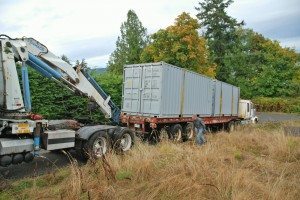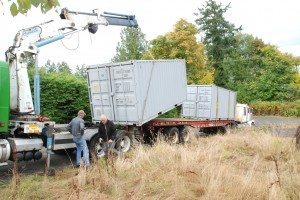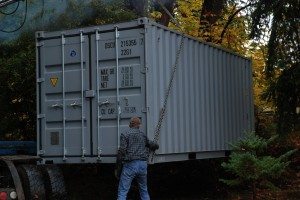
Hi Scott. You were asking if I could write a piece for your blog about our experience of moving across Canada with shipping (sea) containers by train – so here goes. This was a long move – 6000 km from New Brunswick to Salt Spring Island. We wanted a moving option that was going to be as environmentally friendly as possible, and not break the bank. I recall you mentioned that you have had clients who got rid of almost everything and moved via Canada Post! Really, we did think about that option but didn’t want to write off 28 years worth of books and other hobby collections, furniture with sentimental value, and the equipment and inventory of a couple of home businesses in addition to the personal items. We started looking into options:
Moving company – quoted cost was prohibitively expensive even considering I was doing the packing myself; based on CRD aerial view of lot I showed them, moving company said no way they would try to get big truck up the steep and narrow driveway at the new place; would have to unload into smaller trucks at end of driveway and run loads up the driveway with significant (and unpredictable) additional cost. With trucker charging for excess time spent doing this.
– U Haul type truck – as the person on the NB end with the rest of the family already on SSI, I’d be stuck driving their biggest (27 ft) truck across country, solo. And at that, it probably would be too small to fit all the stuff. So what then, truck+trailer? Across the mountains???
– U Boxes – you can rent these plywood boxes from U Haul that you can pick up or have delivered to your house, they then ship them across country to the nearest U Haul (Sidney) and you take them to your new place and unload. They have a big truck that can deliver 4 or 5 at a time but won’t send it to Salt Spring, outside their delivery area (and the truck probably wouldn’t have got up the driveway anyway) so it would have meant renting a trailer from U Haul to move one box at a time (since our car is too small to tow, we’d also need to rent a towing vehicle), which was going to get very expensive very fast in time and ferry costs. Or else rent a big U Haul truck (+trailer?) and offload everything onto it in Sidney for the drive over, then unload a second time at home.
– Checked into other kinds of rental moving ‘pods’ – lots of companies advertise these on the internet, but try finding any that operate east of Ontario! One of the companies could have picked up in NB, but wouldn’t deliver west of Vancouver.

– Intermodal delivery with rented shipping container(s) – Would have been a good option for reasons described below, but in NB the only size available was the 53 ft long container (this varies provincially), and there was no way that was going up the Salt Spring driveway. Another case of unloading and running loads up the driveway with smaller trucks. The other problem is that these rented intermodal containers are brought to your house on a truck chassis 4 feet off the ground, which is fine if you have a loading bay but not so good for household moves – they don’t provide a ramp, you have to come up with something to use – and they expect you to load and unload in a few hours (think it may be 4 hours?) after which you pay something like $75/hr for additional waiting time. Again, that’s fine for an industrial situation where you’d be loading uniform sized items with a front end loader, not so much when you’re trying to place weird sized boxes and furniture. In some cities where it’s convenient for them, they will drop it off for 48 hours of loading or unloading with no additional charge, but obviously that wasn’t going to happen at either end of our trip.
– Intermodal delivery with purchased shipping containers – This is what we eventually decided to do, with 2 20-foot sea containers. We liked the environmental aspects of this option – shipping by rail produces significantly lower greenhouse gas emissions than the equivalent trucking (at least a 4 to 8-fold reduction, depending on whose calculations you believe); we like that it’s helping keep the railways in business; it’s a way of recycling shipping containers (only about 1/3 of the containers that are shipped to North America each year actually make the return voyage, which says something alarming about our balance of trade, don’t you think?); we were planning to construct some outbuildings at the new place anyway, and the containers were cheaper and better than anything of equivalent size we would have built.

So, for anyone interested in this option, these are the steps:
– Contacted an intermodal agent (CN wouldn’t deal with us directly because it was a household move) to get a quote. The transportation-only part of our move actually worked out to be more expensive than the ‘full package’ deal from the intermodal agent (renting their container and letting them handle all aspects of the transport) but we couldn’t use their package deal for the reasons described above. If you are planning to use your own containers, you also have to provide photos of the containers and a safety certificate that apparently all containers have, to prove that they are fit to go on the train. We did this before we completed the purchase of the containers, just in case.
– Book the rail trip with the intermodal company. We got a discount because for some reason CN had a sale on Mondays for a limited time – this varies.
– Bought the containers from a storage company in NB. (Google ‘sea containers’ and your location to find a vendor.)
– Had them delivered to our driveway using a flatbed tow truck. They put the containers at ground level for loading.
– Bought locks for the doors. I mail-ordered a single-use locking bar for each container, and also a heavy-duty padlock. (Google ‘security seals for containers’ and/or talk to a locksmith about hardened-steel padlocks)
– Had them picked up by a different company with bigger truck that could handle the extra weight of the loaded containers, and taken to the railyard on our assigned date.
– Shipped to Vancouver via CN. This was supposed to take a week but they came in 2 days early, on a Saturday, which was a pain because CN will store them for 2 days and then starts charging $200 a day for ‘storage’.
– Fortunately we’d already lined up a Salt Spring hauler to pick them up in Vancouver and he was willing to rearrange his Monday on pretty short notice to save us those storage fees. Then we waited a couple of days for the rain to stop and driveway to dry out a bit. It had been decided that the big truck that went to Vancouver wouldn’t be going up the driveway – the containers were winched off onto a smaller tow truck and taken up one at a time. (We thought that step would be more of an adventure than it turned out to be, but in fact it went pretty smoothly.) We’ve been slowly emptying them out…it’s great not to have to rush this job, makes for less chaos in the house. Basically we’ll finish taking out and putting away the things we can easily manage, and then hire some help for a couple of hours to shift the heavier items.
– Once the containers are empty, our very helpful local company will come back in and line them up neatly where we want them. And then we have instant usable space. How can that get any better?
– I don’t have all the invoices in hand yet, so can’t say exactly what this cost. But I can say that even counting the purchase of the containers it was about 2/3 of what I was quoted for a mover-move. If you don’t include that purchase price – which was probably a bit lower than the cost of a very basic prefab wooden shed of comparable square footage, delivered – the cost of the move itself was probably closer to half of a mover-move. I’m not counting the value of my time here.

Scott, this has turned out to be a much longer explanation than I expected but maybe can save someone else some time on figuring all this out. It was a definite learning experience – I learned some fascinating stuff about the transportation system – took time to figure all this out and was a bit stressful at times, but I would do this again in a heartbeat.
All the best, A.
Thanks, great article.
Cheers,
Scott & June Simmons
The Salt Spring Team

Hi Scott,
Thanks for the information, whome did you use on Salt Spring to get the containers shipped from CN Vancouver to Salt Spring?
Thanks
Future salt spring Islanders, coming from Montreal
Frank and Aurelia
The person on Salt Spring is Ward Drummond his number is two five zero – five three seven – seven one nine five
Do you sell Seacans or know where I could get one? I need a “20”!
They are hard to find now. Cheers Scott